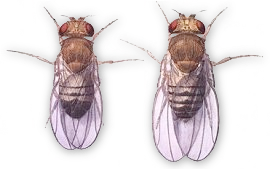Moreover, evolution and behavior exert reciprocal influences on each other - while evolution can diversify behavior, behavior can constrain the evolution of species. For example, in sympatric speciation, behavior provides the reproductive barrier between sub-populations whose hybrid offspring have reduced fitness. In another classic example, two species of periodic cicada with overlapping range emerge to mate after different prime-numbered year intervals, a behavioral strategy that reduces the evolutionary pressures associated with multiple swarms emerging in the same year and periodically abundant predators.
The goal of our lab is to understand the
neurobiological mechanisms of ecologically and evolutionarily relevant behaviors
using techniques drawn from circuit-driven neuroscience, comparative
genomics, and ethology, as they are manifested in fruit flies from
the genus Drosophila.

We have previously worked on projects in several other fields of biology, including: cell biology, microbiology, metabolism, systems biology, and arthropod systematics.
This genetic plasticity likely has mediated the strain and species-level differences in phototaxis we have observed using a number of assays. We are currently using quantitative trait localization to identify the genetic loci responsible for the behavioral differences between several pairs of Drosophila species and strains.
We have found that even in isogenized stocks of fruit flies, individuals display idiosyncratic behaviors in a number of paradigms. In all strains tested, whether they prefer on average to run toward light or darkness when startled, some individuals are more photo-positive or photo-negative than their clonal siblings. While not showing a species-level bias, individual flies prefer to choose either left or right turns in branching mazes. These idiosyncrasies are not heritable, but last the lifetime of the flies, and therefore constitute a form of personality.
We are addressing this question using dimension-reducing analytic methods on high-resolution temporal and spatial data of single flies performing spontaneous walking behavior on floating balls.